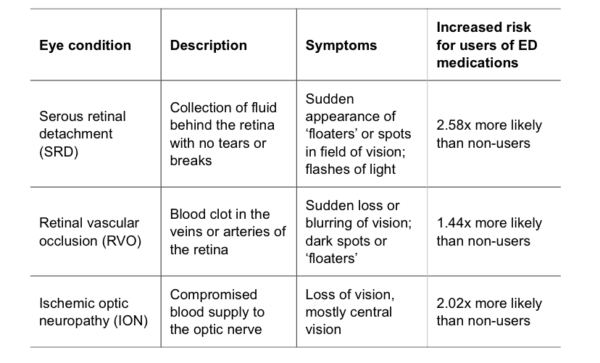The risk of developing one of three serious eye conditions increases by 85 per cent for regular users of common erectile dysfunction (ED) medications such as Viagra, Cialis, Levitra and Stendra, new UBC research has found.
Two of the three conditions had previously been linked to ED medications only by anecdotal case studies. Those links are now confirmed for the first time by a large, epidemiological study, published today in JAMA Ophthalmology.
“These are rare conditions, and the risk of developing one remains very low for any individual user. However, the sheer number of prescriptions dispensed each month in the U.S.—about 20 million—means that a significant number of people could be impacted,” said Dr. Mahyar Etminan, an associate professor in the department of ophthalmology and visual sciences at the UBC faculty of medicine. “Regular users of these drugs who find any changes in their vision should take it seriously and seek medical attention.”
Following insurance claims
The researchers analyzed health insurance claim records of 213,000 men in the U.S. who had not experienced any of these eye problems in the year before they became regular users of ED medications.
They followed the records to see how many men developed one or more of the three conditions, and how that rate compared to men who didn’t use the medications. After accounting statistically for other conditions such as hypertension, diabetes and coronary artery disease that are known to be associated with eye problems, they found the increased risk for each to be as follows:

A possible explanation
The study showed only the statistical association between eye conditions and use of Viagra, Cialis, Levitra or Stendra. It did not prove that the drugs cause these conditions.
However, ED medications function in a way that suggests some possible explanations.
“These medications address erectile dysfunction by improving blood flow, but we know that they can also hinder blood flow in other parts of the body,” said Dr. Etminan. “So although our study doesn’t prove cause-and-effect, there is a mechanism by which these medications could conceivably lead to these problems. The totality of the evidence points toward a strong link.”
Warnings needed
The potential risk of SRD and RVO is not addressed in the information currently provided to patients along with their ED medications, unlike the ION risk which has been demonstrated by previous research.
Dr. Etminan hopes his team’s work will change that. Patients who are unaware of all potential side effects might not seek help in time to avoid serious visual consequences.









Comments
NOTE: The North Shore Daily Post welcomes your opinions and comments. We do not allow personal attacks, offensive language or unsubstantiated allegations. We reserve the right to edit comments for length, style, legality and taste and reproduce them in print, electronic or otherwise. For further information, please contact the editor or publisher, or see our Terms and Conditions.